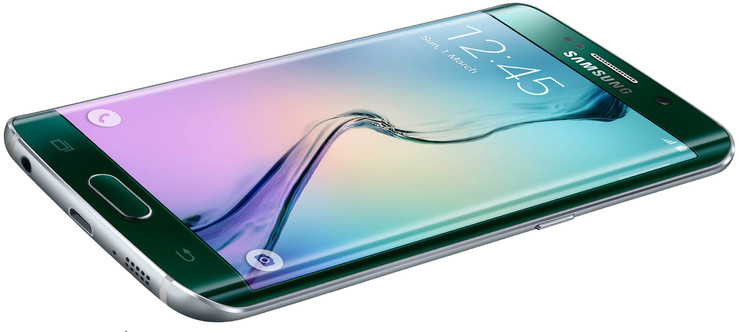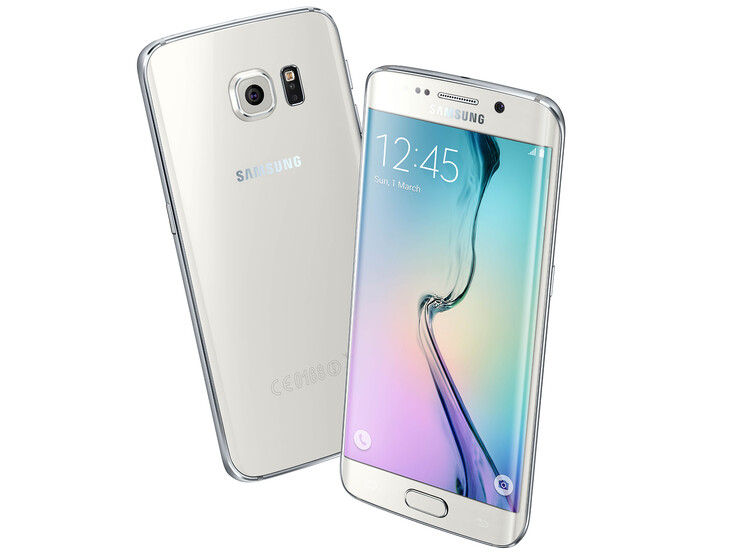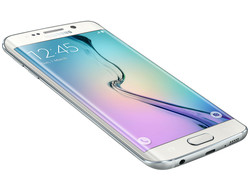Samsung Galaxy S6 Edge First Impressions

For the original German preview, see here.
With the Samsung Galaxy S6 Edge, things have really changed for the Koreans. It is not just, as was the case in the Galaxy S6, that aluminum and Corning Gorilla Glass 4 is used instead of plastics, but the display is also rounded on both sides.
In terms of technology, the test device comes with a fast Exynos 7420 processor from Samsung, which is now supported by 3 GB of RAM. While the 64-bit OS Google Android 5.0.2 would actually support a larger RAM capacity, the manufacturer has refrained from using more. Regarding storage options, models are available with 32, 64 and 128 GB. For each doubling of storage capacity, the price increases by 100 Euros (~$108). Since Samsung has dispensed with a memory card slot, it is not possible to add memory cheaply. This is reminiscent of the bad price policy of the major competitor, Cupertino.
The competition does not have such curved displays. LG follows a different approach with its curved panels. Only the Samsung Galaxy Note 4 Edge features at least one curved display edge, but it is still a separate display. It is in the S6 Edge that for the first time, the edges of the main display are actually curved.
First Impressions
We like the shape of the Samsung Galaxy S6 Edge and the design with both display edges curved is actually unique in the smartphone market so far. Not only is the shape exclusive, but also the materials. The Korean manufacturer has forgone plastic, and uses a robust aluminum frame, whose corners are vaguely reminiscent of the Moto X. The display as well as the rear side are protected by scratch resistant Corning Gorilla Glass 4. The case appears to be very stable. It does neither creak nor twist when force is applied.
In terms of features, the RAM capacity is 50% larger than that of the S5. Unfortunately, the USB-3.0 port was replaced by the predecessor 2.0. The communication features are up-to-date and promise high transfer rates. Regrettably, the new generation is no longer IP certified, which is reserved for the upcoming Galaxy S6 Active (we reported). In addition, the battery is now fixed, and you will look for a microSD slot is vain. Sadly, Samsung has omitted familiar and proven features here.
Cameras
The Samsung Galaxy S6 and the S6 Edge use the same cameras, which are premium features in this smartphone generation, since they were improved by the manufacturer. The front camera now features a resolution of 5 MP, while in the Galaxy S5 it was only 2 MP. Although the main camera's resolution of 16 MP is identical with that of the predecessor, its performance has greatly improved. In low light environments in particular, the camera can now shoot good images. This is partly because the camera now offers an f/1.9 aperture. It is a big challenge to avoid overexposure with such light-sensitive lens, but the Galaxy S6 Edge has done a good job in this aspect. The camera in the Samsung smartphone is one of the best currently available in mobile devices.
Display
Compared to the S5 predecessor, the Samsung Galaxy S6 Edge has the same 5.1-inch display size. Once again, the excellent Super AMOLED technology is used that has been further improved. The spec lists a higher resolution. With QHD (2560x1440 px, 16:9), the test model features the same resolution as the Galaxy Note 4 and reaches a high pixel density of 576 ppi. Brightness distribution and brightness are very good and emphasize the superb first impression.
| |||||||||||||||||||||||||
Brightness Distribution: 94 %
Center on Battery: 343 cd/m²
Contrast: ∞:1 (Black: 0 cd/m²)
ΔE ColorChecker Calman: 2.2 | ∀{0.5-29.43 Ø4.77}
ΔE Greyscale Calman: 2.37 | ∀{0.09-98 Ø5}
87.77% AdobeRGB 1998 (Argyll 1.6.3 3D)
Gamma: 2.41
CCT: 6425 K
| Samsung Galaxy S6 Edge Mali-T760 MP8, Exynos 7420, 32 GB UFS 2.0 Flash | Samsung Galaxy S5 Adreno 330, 801 MSM8974AC, 16 GB eMMC Flash | HTC One M9 Adreno 430, 810 MSM8994, 32 GB eMMC Flash | Apple iPhone 6 PowerVR GX6450, A8, 128 GB eMMC Flash | Motorola Moto X 2. Gen 2014 Adreno 330, 801 MSM8974AC, 16 GB eMMC Flash | Nokia Lumia 930 Adreno 330, 800 MSM8974, 32 GB eMMC Flash | |
|---|---|---|---|---|---|---|
| Screen | -47% | -54% | -13% | -55% | -139% | |
| Brightness middle (cd/m²) | 343 | 358 4% | 474 38% | 520 52% | 259 -24% | 275 -20% |
| Brightness (cd/m²) | 338 | 364 8% | 458 36% | 511 51% | 263 -22% | 278 -18% |
| Brightness Distribution (%) | 94 | 82 -13% | 85 -10% | 88 -6% | 91 -3% | 89 -5% |
| Black Level * (cd/m²) | 0.4 | 0.61 | ||||
| Colorchecker dE 2000 * | 2.2 | 5.28 -140% | 6.32 -187% | 3.92 -78% | 6.52 -196% | 10.99 -400% |
| Greyscale dE 2000 * | 2.37 | 4.65 -96% | 6.36 -168% | 4.33 -83% | 3.05 -29% | 8.29 -250% |
| Gamma | 2.41 91% | 2.48 89% | 2.43 91% | 2.46 89% | 2.31 95% | 2.16 102% |
| CCT | 6425 101% | 7690 85% | 8218 79% | 7384 88% | 6226 104% | 6731 97% |
| Color Space (Percent of AdobeRGB 1998) (%) | 87.77 | 58.81 -33% | ||||
| Contrast (:1) | 1185 | 852 |
* ... smaller is better
Performance
Because of alleged heating problems of the Qualcomm Snapdragon 810, the Korean's own SoCs are also used in Europe. With the Exynos 7420, the company offers a powerful 64-bit-capable high-end SoC with eight cores. The faster Cortex-A57 cores clock up to 2.1 GHz and the Cortex-A53 series clocks up to 1.5 GHz. The latter should enable energy-efficient operation. If needed, all four cores can calculate simultaneously. Apart from the higher clock, the processor is very similar to the Snapdragon 810, but Samsung already uses the modern 14 nm lithography. This does not only bring thermal advantages, but also the performance is nothing to sneeze at.
In the first benchmarks, the Samsung Galaxy S6 Edge partially outclassed its competition. The lead is especially big in AnTuTu v5. However, 3DMark shows that the integrated GPU ARM Mali-T760 MP8 cannot completely keep up with the Qualcomm Adreno 430. We will examine the differences in more detail in our in-depth review.
| AnTuTu v5 - Total Score (sort by value) | |
| Samsung Galaxy S6 Edge | |
| OnePlus One | |
| HTC One M9 | |
| Apple iPhone 6 | |
| Google Nexus 6 | |
| LG G3 | |
| Geekbench 3 | |
| 32 Bit Single-Core Score (sort by value) | |
| Samsung Galaxy S6 Edge | |
| Samsung Galaxy S5 | |
| OnePlus One | |
| HTC One M9 | |
| Apple iPhone 6 | |
| Google Nexus 6 | |
| LG G3 | |
| 32 Bit Multi-Core Score (sort by value) | |
| Samsung Galaxy S6 Edge | |
| Samsung Galaxy S5 | |
| OnePlus One | |
| HTC One M9 | |
| Apple iPhone 6 | |
| Google Nexus 6 | |
| LG G3 | |
| 3DMark | |
| 1280x720 offscreen Ice Storm Unlimited Score (sort by value) | |
| Samsung Galaxy S6 Edge | |
| Samsung Galaxy S5 | |
| OnePlus One | |
| HTC One M9 | |
| Apple iPhone 6 | |
| Google Nexus 6 | |
| LG G3 | |
| 1280x720 offscreen Ice Storm Unlimited Graphics Score (sort by value) | |
| Samsung Galaxy S6 Edge | |
| Samsung Galaxy S5 | |
| OnePlus One | |
| HTC One M9 | |
| Apple iPhone 6 | |
| Google Nexus 6 | |
| LG G3 | |
| 1280x720 offscreen Ice Storm Unlimited Physics (sort by value) | |
| Samsung Galaxy S6 Edge | |
| Samsung Galaxy S5 | |
| OnePlus One | |
| HTC One M9 | |
| Apple iPhone 6 | |
| Google Nexus 6 | |
| LG G3 | |
| AndroBench 3-5 | |
| Sequential Read 256KB (sort by value) | |
| Samsung Galaxy S6 Edge | |
| Samsung Galaxy S5 | |
| OnePlus One | |
| HTC One M9 | |
| Google Nexus 6 | |
| LG G3 | |
| Sequential Write 256KB (sort by value) | |
| Samsung Galaxy S6 Edge | |
| Samsung Galaxy S5 | |
| OnePlus One | |
| HTC One M9 | |
| Google Nexus 6 | |
| LG G3 | |
| Random Read 4KB (sort by value) | |
| Samsung Galaxy S6 Edge | |
| Samsung Galaxy S5 | |
| OnePlus One | |
| HTC One M9 | |
| Google Nexus 6 | |
| LG G3 | |
| Random Write 4KB (sort by value) | |
| Samsung Galaxy S6 Edge | |
| Samsung Galaxy S5 | |
| OnePlus One | |
| HTC One M9 | |
| Google Nexus 6 | |
| LG G3 | |
| Peacekeeper - --- (sort by value) | |
| Samsung Galaxy S6 Edge | |
| Samsung Galaxy S5 | |
| OnePlus One | |
| HTC One M9 | |
| Nokia Lumia 930 | |
| Apple iPhone 6 | |
| LG G3 | |
* ... smaller is better
(+) The maximum temperature on the upper side is 38.9 °C / 102 F, compared to the average of 35.2 °C / 95 F, ranging from 21.9 to 247 °C for the class Smartphone.
(+) The bottom heats up to a maximum of 37.9 °C / 100 F, compared to the average of 34 °C / 93 F
(+) In idle usage, the average temperature for the upper side is 28.8 °C / 84 F, compared to the device average of 32.9 °C / 91 F.
Energy & Battery Life
The power consumption of the Samsung Galaxy S6 Edge is slightly higher than that of the predecessor, especially in the load scenario. However, the differences are not huge, so the battery life should be similar to the Galaxy S5 (2800 mAh), if it was not for the smaller battery with a capacity of 2600 mAh.
On the other hand, the Galaxy series smartphones can also be charged without cable now. However, charging will take less time via cable since Samsung supports Fast Charge.
| Off / Standby | |
| Idle | |
| Load |
|
Key:
min: | |
Preliminary Verdict
Like its slimmer Galaxy S6 sibling, the Samsung Galaxy S6 Edge aims for the smartphone crown. The completely new design is definitely well made. Apart from high performance, the buyer gets a good camera. Samsung has greatly made up ground and is at least on par with competitors like the iPhone 6 and the Lumia 930.
The storage solution of the Korean's is a disadvantage. Although there are three different options, an upgrade is expensive and can increase the price of the smartphone to up to 1049 Euro (~$1135); an almost absurd amount. Therefore, we miss the possibility to enhance the storage capacity with a microSD card even more.
In addition, we expect a shorter battery life due to slightly higher power consumption and a smaller battery. The overdue integration of wireless charging can only slightly compensate for this.
The new S6 models are a step in the right direction anyway. Samsung has come up with many ideas, but unfortunately has also omitted proven features.










